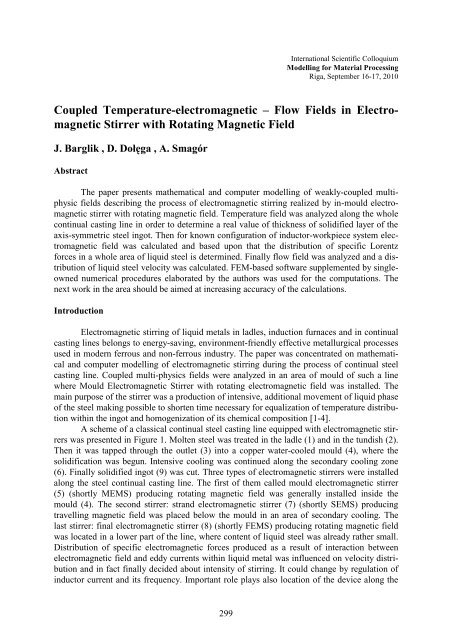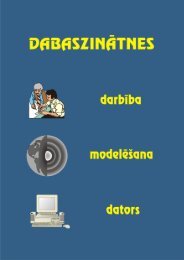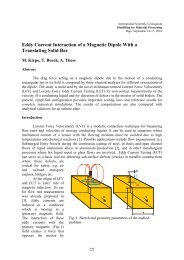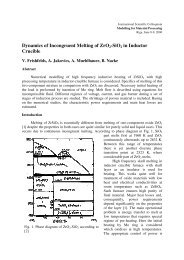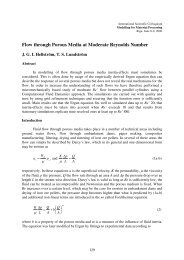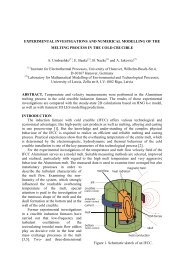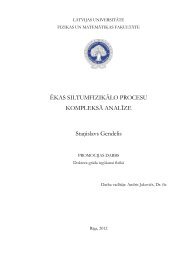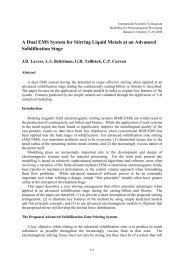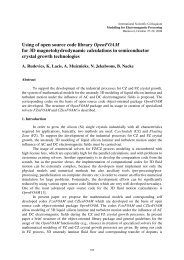Flow Fields in Electromagnetic Stirrer with Rotating Magnetic Field
Flow Fields in Electromagnetic Stirrer with Rotating Magnetic Field
Flow Fields in Electromagnetic Stirrer with Rotating Magnetic Field
You also want an ePaper? Increase the reach of your titles
YUMPU automatically turns print PDFs into web optimized ePapers that Google loves.
International Scientific Colloquium<br />
Modell<strong>in</strong>g for Material Process<strong>in</strong>g<br />
Riga, September 16-17, 2010<br />
Coupled Temperature-electromagnetic – <strong>Flow</strong> <strong><strong>Field</strong>s</strong> <strong>in</strong> <strong>Electromagnetic</strong><br />
<strong>Stirrer</strong> <strong>with</strong> Rotat<strong>in</strong>g <strong>Magnetic</strong> <strong>Field</strong><br />
J. Barglik , D. Dołęga , A. Smagór<br />
Abstract<br />
The paper presents mathematical and computer modell<strong>in</strong>g of weakly-coupled multiphysic<br />
fields describ<strong>in</strong>g the process of electromagnetic stirr<strong>in</strong>g realized by <strong>in</strong>-mould electromagnetic<br />
stirrer <strong>with</strong> rotat<strong>in</strong>g magnetic field. Temperature field was analyzed along the whole<br />
cont<strong>in</strong>ual cast<strong>in</strong>g l<strong>in</strong>e <strong>in</strong> order to determ<strong>in</strong>e a real value of thickness of solidified layer of the<br />
axis-symmetric steel <strong>in</strong>got. Then for known configuration of <strong>in</strong>ductor-workpiece system electromagnetic<br />
field was calculated and based upon that the distribution of specific Lorentz<br />
forces <strong>in</strong> a whole area of liquid steel is determ<strong>in</strong>ed. F<strong>in</strong>ally flow field was analyzed and a distribution<br />
of liquid steel velocity was calculated. FEM-based software supplemented by s<strong>in</strong>gleowned<br />
numerical procedures elaborated by the authors was used for the computations. The<br />
next work <strong>in</strong> the area should be aimed at <strong>in</strong>creas<strong>in</strong>g accuracy of the calculations.<br />
Introduction<br />
<strong>Electromagnetic</strong> stirr<strong>in</strong>g of liquid metals <strong>in</strong> ladles, <strong>in</strong>duction furnaces and <strong>in</strong> cont<strong>in</strong>ual<br />
cast<strong>in</strong>g l<strong>in</strong>es belongs to energy-sav<strong>in</strong>g, environment-friendly effective metallurgical processes<br />
used <strong>in</strong> modern ferrous and non-ferrous <strong>in</strong>dustry. The paper was concentrated on mathematical<br />
and computer modell<strong>in</strong>g of electromagnetic stirr<strong>in</strong>g dur<strong>in</strong>g the process of cont<strong>in</strong>ual steel<br />
cast<strong>in</strong>g l<strong>in</strong>e. Coupled multi-physics fields were analyzed <strong>in</strong> an area of mould of such a l<strong>in</strong>e<br />
where Mould <strong>Electromagnetic</strong> <strong>Stirrer</strong> <strong>with</strong> rotat<strong>in</strong>g electromagnetic field was <strong>in</strong>stalled. The<br />
ma<strong>in</strong> purpose of the stirrer was a production of <strong>in</strong>tensive, additional movement of liquid phase<br />
of the steel mak<strong>in</strong>g possible to shorten time necessary for equalization of temperature distribution<br />
<strong>with</strong><strong>in</strong> the <strong>in</strong>got and homogenization of its chemical composition [1-4].<br />
A scheme of a classical cont<strong>in</strong>ual steel cast<strong>in</strong>g l<strong>in</strong>e equipped <strong>with</strong> electromagnetic stirrers<br />
was presented <strong>in</strong> Figure 1. Molten steel was treated <strong>in</strong> the ladle (1) and <strong>in</strong> the tundish (2).<br />
Then it was tapped through the outlet (3) <strong>in</strong>to a copper water-cooled mould (4), where the<br />
solidification was begun. Intensive cool<strong>in</strong>g was cont<strong>in</strong>ued along the secondary cool<strong>in</strong>g zone<br />
(6). F<strong>in</strong>ally solidified <strong>in</strong>got (9) was cut. Three types of electromagnetic stirrers were <strong>in</strong>stalled<br />
along the steel cont<strong>in</strong>ual cast<strong>in</strong>g l<strong>in</strong>e. The first of them called mould electromagnetic stirrer<br />
(5) (shortly MEMS) produc<strong>in</strong>g rotat<strong>in</strong>g magnetic field was generally <strong>in</strong>stalled <strong>in</strong>side the<br />
mould (4). The second stirrer: strand electromagnetic stirrer (7) (shortly SEMS) produc<strong>in</strong>g<br />
travell<strong>in</strong>g magnetic field was placed below the mould <strong>in</strong> an area of secondary cool<strong>in</strong>g. The<br />
last stirrer: f<strong>in</strong>al electromagnetic stirrer (8) (shortly FEMS) produc<strong>in</strong>g rotat<strong>in</strong>g magnetic field<br />
was located <strong>in</strong> a lower part of the l<strong>in</strong>e, where content of liquid steel was already rather small.<br />
Distribution of specific electromagnetic forces produced as a result of <strong>in</strong>teraction between<br />
electromagnetic field and eddy currents <strong>with</strong><strong>in</strong> liquid metal was <strong>in</strong>fluenced on velocity distribution<br />
and <strong>in</strong> fact f<strong>in</strong>ally decided about <strong>in</strong>tensity of stirr<strong>in</strong>g. It could change by regulation of<br />
<strong>in</strong>ductor current and its frequency. Important role plays also location of the device along the<br />
299
l<strong>in</strong>e because of cont<strong>in</strong>ual decreas<strong>in</strong>g of liquid phase of steel <strong>with</strong> the <strong>in</strong>creased distance from<br />
the mould.<br />
a) b) c)<br />
1<br />
2<br />
3<br />
4<br />
5<br />
6<br />
7<br />
8<br />
9<br />
10<br />
Fig.1. Cont<strong>in</strong>ual cast<strong>in</strong>g l<strong>in</strong>e <strong>with</strong> three electromagnetic stirrers: a) scheme of the l<strong>in</strong>e 1 –<br />
ladle, 2 - tundish, 3 – outlet, 4 – mould, 5 – MEMS stirrer, 6 – cool<strong>in</strong>g zone, 7 – SEMS stirrer,<br />
8 – FEMS stirrer, 9 – solidified <strong>in</strong>got and roll<strong>in</strong>g system, 10 – cutt<strong>in</strong>g mach<strong>in</strong>e b, c) model and<br />
view of MEMS stirrer<br />
This particular paper was concentrated on phenomena tak<strong>in</strong>g place <strong>in</strong> an area of<br />
MEMS stirrer picked <strong>in</strong> Figure 1 <strong>with</strong> red l<strong>in</strong>e.<br />
1. Mathematical Model<br />
The analyzed model of electromagnetic stirr<strong>in</strong>g deals <strong>with</strong> the weakly-coupled temperature,<br />
electromagnetic and flow field. Temperature field should be analyzed along the<br />
whole steel cont<strong>in</strong>ual cast<strong>in</strong>g l<strong>in</strong>e <strong>in</strong> order to determ<strong>in</strong>e decreas<strong>in</strong>g thickness of solidified layer<br />
of the <strong>in</strong>got along the length of the cast<strong>in</strong>g l<strong>in</strong>e (<strong>in</strong>creas<strong>in</strong>g distance from the free liquid <strong>in</strong>got<br />
surface <strong>in</strong> the mould). Computations start <strong>with</strong> the determ<strong>in</strong>ation of temperature field distribution.<br />
The temperature distribution was described by Fourier-Kirchhoff equation:<br />
T<br />
div gradT c v grad T c pv<br />
, (1.1)<br />
t<br />
where T denotes temperature, - specific thermal conductivity, - density, c – specific heat,<br />
v – velocity, and p v total specific external heat source.<br />
Boundary conditions hav<strong>in</strong>g both convection and radiation were taken <strong>in</strong>to consideration [4]<br />
However for a simplified analysis presented <strong>in</strong> the paper it was assumed that electromagnetic<br />
300
field was not <strong>in</strong>fluenced on temperature distribution <strong>with</strong><strong>in</strong> the <strong>in</strong>got, so p v could be considered<br />
as zero also <strong>in</strong> area of electromagnetic stirrers. Analysis of temperature field makes it<br />
possible to determ<strong>in</strong>e thickness of solidified layer of the <strong>in</strong>got b <strong>in</strong> dependence of distance<br />
from the liquid metal free surface <strong>in</strong> the mould.<br />
In order to shorten a time of computations electromagnetic field was considered <strong>in</strong> a<br />
simplified way as quasi-stationary field and was given by the solution for the phasor A of the<br />
magnetic vector potential A<br />
curlcurl A j A v curl A J<br />
z , (1.2)<br />
where μ denotes magnetic permeability, - conductivity, J z - vector of the external current<br />
density <strong>in</strong> the field coil., j - the imag<strong>in</strong>ary unit, ω - the angular frequency.<br />
Due to relatively low velocity of liquid metal movement the third term of the equation<br />
(1.2) can be neglected [5] and the equation was transformed <strong>in</strong>to the classical form of the<br />
Helmholtz equation:<br />
curl curl A j A J , (1.3)<br />
z<br />
The conditions along the axis of the electromagnetic stirrer and on the artificial boundary<br />
placed far enough from the <strong>in</strong>ductor-workpiece system were the Dirichlet type ( A 0). As<br />
the MEMS stirrer may be considered axis-symmetric, the magnetic vector potential A has<br />
only the tangential component. The phasor of eddy currents density produced <strong>in</strong> liquid steel<br />
and the specific Lorentz forces were given as:<br />
J j A ; (1.4)<br />
eddy<br />
fe<br />
Re J curl A<br />
*<br />
eddy , (1.5)<br />
where A * denotes the complex conjugate to A.<br />
metal:<br />
The system of Navier-Stokes and cont<strong>in</strong>uity equations describes the motion of liquid<br />
v<br />
[ + ( v grad) v] = - grad p + g+ d<br />
v fe<br />
t<br />
; (1.6)<br />
div v 0 , (1.7)<br />
where p denotes pressure, g – gravity acceleration and<br />
d<br />
- dynamic viscosity.<br />
Due to turbulent character of the liquid metal flow the dynamic viscosity was determ<strong>in</strong>ed<br />
based upon k - model [6]. The mathematical model presented above was solved by a<br />
comb<strong>in</strong>ation of different FEM-based professional software supplemented by s<strong>in</strong>gle-owned<br />
procedures elaborated by the authors. A way of the temperature calculations was described <strong>in</strong><br />
301
[6]. For analysis of electromagnetic field Matlab and/or Flux 2D/3D packages were applied,<br />
however for flow field the Fluent 2 D program was used. A special emphasis was put on the<br />
convergence of results <strong>in</strong> the dependence of the position of the external artificial boundary<br />
<strong>with</strong> zero Dirichlet condition. Numerical modell<strong>in</strong>g of one computation cycle takes approximately<br />
several m<strong>in</strong>utes.<br />
2. Illustrative Example<br />
The theoretical analysis of coupled temperature – electromagnetic - flow fields was<br />
supplemented by an illustrative example deal<strong>in</strong>g <strong>with</strong> the MEMS electromagnetic stirrer located<br />
at a beg<strong>in</strong>n<strong>in</strong>g of the cont<strong>in</strong>ual cast<strong>in</strong>g l<strong>in</strong>e <strong>in</strong> an area of mould (the MEMS stirrer). The<br />
distribution of liquid steel velocity was determ<strong>in</strong>ed on the basis of the described mathematical<br />
model. Some <strong>in</strong>put data applied for computations were shown below:<br />
<strong>Magnetic</strong> core:<br />
electric conductivity<br />
relative magnetic permeability r = 100<br />
Solidified part of <strong>in</strong>got:<br />
electric conductivity 0,868 . 10 6 S/m<br />
relative magnetic permeability r = 1<br />
temperature T = 1540 o C<br />
cast<strong>in</strong>g speed v c = 0.05 m/s<br />
density ρ = 6920 kg/m 3<br />
dynamic viscosity η d = 6.15 . 10 5 N/s<br />
diameter of the <strong>in</strong>got D = 0.17 m<br />
Liquid part of <strong>in</strong>got:<br />
electric conductivity 0.757 . 10 6 S/m<br />
relative magnetic permeability r = 1<br />
Coils:<br />
electric conductivity 5.5 . 10 7 S/m<br />
relative magnetic permeability r = 1<br />
field current I = 284 A<br />
number of turns n = 88,<br />
frequency f = 4.5 Hz<br />
Distribution of the specific Lorentz forces <strong>with</strong><strong>in</strong> liquid metal <strong>in</strong> the area where the<br />
MEMS stirrer <strong>in</strong>stalled was shown <strong>in</strong> Figure 3. Based upon obta<strong>in</strong>ed distribution of specific<br />
Lorentz forces <strong>in</strong> liquid phase of molten steel a distribution of velocity was determ<strong>in</strong>ed. Some<br />
results of flow field computations were shown <strong>in</strong> Figures 4 - 5. Distribution of tangent component<br />
of velocity on direction of z axis (along the length of the MEMS stirrer) was shown <strong>in</strong><br />
Figure 4. Distribution of tangent component of velocity <strong>in</strong> radial direction (<strong>in</strong> cross-section of<br />
liquid <strong>in</strong>got) for five different positions along the length of the mould was shown <strong>in</strong> Fig.5.<br />
More results of flow field calculations for different parameters of the <strong>in</strong>ductor-workpiece of<br />
the MEMS electromagnetic stirrer system will be presented dur<strong>in</strong>g the sem<strong>in</strong>ar.<br />
302
Fig. 3. Distribution of specific Lorentz forces <strong>in</strong> liquid part of the steel <strong>in</strong>got at low frequency<br />
f = 4.5 Hz<br />
0,07<br />
0.02 m<br />
0.005m<br />
0,06<br />
0.03 m<br />
v , m/s<br />
0,05<br />
0.04 m<br />
0,04<br />
0.048 m<br />
0,03<br />
0,02<br />
0,0045 m 0,01<br />
0<br />
-0,25 -0,15 -0,05 0,05 0,15 z, m 0,25<br />
Fig. 4. Distribution of tangent component of liquid steel velocity <strong>in</strong> direction of z axis (along<br />
the length of the MEMS stirrer) for six different distances from axis of the <strong>in</strong>got<br />
Conclusions<br />
Mathematical modell<strong>in</strong>g of weakly-coupled temperature-electromagnetic-flow fields dur<strong>in</strong>g<br />
electromagnetic stirr<strong>in</strong>g of liquid steel <strong>in</strong> a process of its cont<strong>in</strong>ual cast<strong>in</strong>g of cyl<strong>in</strong>drical <strong>in</strong>gots<br />
was presented <strong>in</strong> the paper. Professional software, ma<strong>in</strong>ly Flux and Fluent packages which<br />
was used for the computations, was supplemented by own-s<strong>in</strong>gle numerical procedures elaborated<br />
by the authors. Calculations were done for MEMS stirrer <strong>in</strong>stalled <strong>in</strong>side the mould. The<br />
results of calculations conta<strong>in</strong> the distribution of the specific Lorentz forces and velocity <strong>with</strong><strong>in</strong><br />
the liquid <strong>in</strong>got. The presented methodology makes it possible to analyze <strong>in</strong>tensity of electromagnetic<br />
stirr<strong>in</strong>g.<br />
303
0,07<br />
0,06<br />
v , m/s<br />
0.05 m<br />
0,05<br />
0<br />
0,04<br />
0,03<br />
0.1 m<br />
0,02<br />
0,01<br />
0.15 m<br />
0.12 m<br />
0<br />
r, m<br />
0 0,01 0,02 0,03 0,04 0,05<br />
Fig. 5. Distribution of tangent component of liquid steel velocity <strong>in</strong> an area of MEMS stirrer<br />
<strong>in</strong> radial direction for five different positions along the length of the stirrer<br />
Acknowledgement<br />
F<strong>in</strong>ancial support of the Polish M<strong>in</strong>istry of Science and Higher Education under grant<br />
project NN 508 388637 was highly acknowledged.<br />
References<br />
[1] Barglik, J., Golak, S., Pragłowska-Gorczyńska, Z., Przyłucki, R., Smagór, A.: Magnetohydrodynamics <strong>in</strong><br />
metallurgical Applications. Proceed<strong>in</strong>gs of the 10th International Conference "Electric Power Eng<strong>in</strong>eer<strong>in</strong>g”,<br />
2009.<br />
[2] Barglik, J., Smagór, A.: Some aspects of electromagnetic stirr<strong>in</strong>g process of cont<strong>in</strong>ual steel cast<strong>in</strong>g. Proceed<strong>in</strong>gs<br />
of the 6 th International Conference on Process<strong>in</strong>g of Materials. Dresden , 2009, pp. 684-687.<br />
[3]. Barglik, J., Czerwiński, M., Her<strong>in</strong>g, M., Wesołowski, M.: Radiation <strong>in</strong> Modell<strong>in</strong>g of Induction Heat<strong>in</strong>g Systems.<br />
IOS Press Amsterdam, Berl<strong>in</strong>, Oxford, Tokyo, Wash<strong>in</strong>gton DC, 2008, pp. 202-211.<br />
[4] Barglik, J., Dołęga, D., Smagór, A.: Mathematical modell<strong>in</strong>g of electromagnetic stirr<strong>in</strong>g dur<strong>in</strong>g process of<br />
cont<strong>in</strong>ual steel cast<strong>in</strong>g. Proceed<strong>in</strong>gs of the HES 2010. Padua , 2010, pp. 19-26.<br />
[5] Barglik, J., Doležel, I., Ulrych, B.: Induction heat<strong>in</strong>g of mov<strong>in</strong>g materials. Acta Technica CSAV, Academy<br />
of Sciences of the Czech Republic, Prague, Vol. 43, 1998, pp. 515-527.<br />
[6] Sajdak, C., Mazur, A.: Simulation of solidification of liquid steel <strong>in</strong>gots. Proceed<strong>in</strong>gs of the International<br />
Conference - “Iron&Steelmak<strong>in</strong>g”, 2006.<br />
Authors<br />
Prof. Barglik, Jerzy<br />
Dr Ing Dołęga, Dagmara<br />
MSc Smagór, Adrian<br />
Faculty of Material Sciences and Metallurgy,<br />
Silesian University of Technology,<br />
ul. Krasińskiego 8,<br />
40-019 Katowice, Poland<br />
E-mail: jerzy.barglik@polsl.pl<br />
dagmara.dolega@polsl.pl<br />
adrian.smagor@polsl.pl<br />
304


